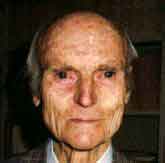Mathematics and Art
4. Mathematical artists and artist mathematicians
Not surprisingly, in light of the internal aesthetic qualities of mathematics, many mathematicians (and computer scientists) have chosen to express themselves not only by proving theorems but also by producing art. There are many such individuals including Helaman Ferguson, Nathaniel Friedman (also see this site), George Hart, Koos Verhoeff, and Michael Field. Complementing these career "mathematicians" who are also artists is a group of people who are not mathematicians but who have drawn great inspiration from mathematical phenomena. Some such individuals are Brent Collins, Charles Perry, and Sol LeWit (here are more samples of his work). As might be expected, there are many architects whose work has a feeling of having been influenced by "technical capability." Though perhaps having only a tangential connection with mathematics, the distinguished architect Frank Gehry has discussed how the availability of CAD (Computer Aided Design) software has made it possible for him to express himself in a way that would not have otherwise been possible. Structural engineering has many ties with mathematics. If you are not familiar with the work of Santiago Calatrava, you are in for a treat. There have also been attempts of various kinds to generate art with algorithms. Some of this work is rather interesting.
For the general public, there is one artist whose work, perhaps more than any other, is seen as having a mathematical quality. This artist was M. C. Escher. The mathematical quality of his work is apparent even though Escher did not see himself as having mathematical talent. Yet despite his lack of formal study of mathematics, Escher approached many artistic problems in a mathematical way. Doris Schattschneider has been instrumental in calling to the public's attention Escher's work and its relation to mathematics. Escher was influenced by at least one very distinguished mathematician (geometer), Harold Scott MacDonald Coxeter. Escher interacted with Coxeter about the difficulties he was having with representing "infinity" in a finite region. Coxeter responded by showing the connection to tilings of the hyperbolic plane. Coxeter has explained the details of this mathematical connection. Mathematically active until his death, Coxeter recently passed away at the age of 96 (an obituary is here). .

-
Introduction
-
Mathematical tools for artists
-
Symmetry
-
Mathematical artists and artist mathematicians
-
Polyhedra, tilings, and dissections
-
Origami
-
References
Welcome to the
Feature Column!
These web essays are designed for those who have already discovered the joys of mathematics as well as for those who may be uncomfortable with mathematics.
Read more . . .
Feature Column at a glance



